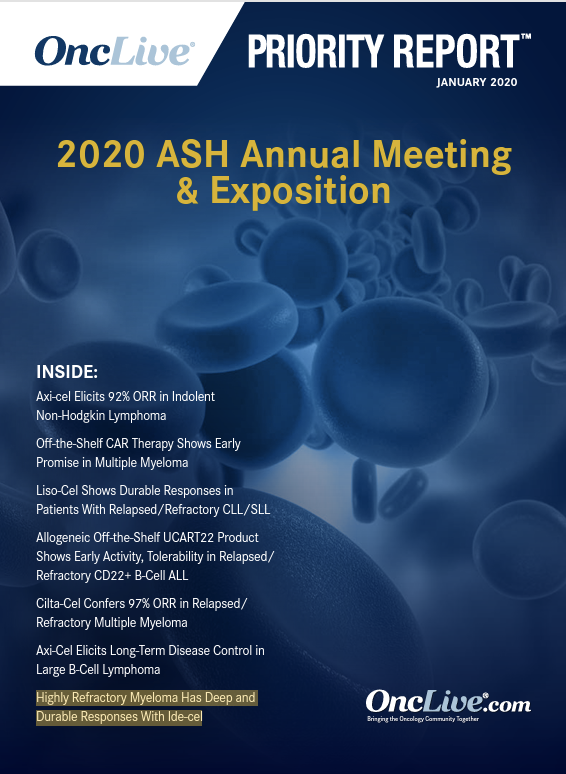Publication
Article
Supplements and Featured Publications
Allogeneic Off-the-Shelf UCART22 Product Shows Early Activity, Tolerability in Relapsed/Refractory CD22+ B-Cell ALL
Author(s):
December 6, 2020 - UCART22, an allogeneic off-the-shelf CD22-directed T-cell product, showed no unexpected toxicities at 2 dose levels and had early signs of activity in adult patients with relapsed/refractory CD22-positive B-cell acute lymphoblastic leukemia.
Nitin Jain, MD

UCART22, an allogeneic off-the-shelf CD22-directed T-cell product, showed no unexpected toxicities at 2 dose levels and had early signs of activity in adult patients with relapsed/refractory CD22-positive B-cell acute lymphoblastic leukemia (ALL), according to results of the phase 1 BALLI-01 study (NCT04150497) that were presented during the 2020 ASH Annual Meeting.1
In the dose-escalation and dose-expansion study, 2 patients at the 1 x 105 cells/kg dose achieved a complete remission (CR) with incomplete hematologic recovery on day 28. One of these patients attained a minimal residual disease (MRD)–positive CR at day 42 followed by subsequent inotuzumab ozogamicin (Besponsa) and then transplant.
One patient at dose level 2, 1 x 106 cells/kg, experienced a significant bone marrow blast reduction at day 28, followed by disease progression.
No patients experienced dose-limiting toxicities (DLTs), immune effector cell–associated neurotoxicity syndrome (ICANS), graft-versus-host disease (GVHD), adverse effects (AE) of special interest (AESI), a UCART22-related AE that was grade 3 or higher, or a serious AE (SAE).
“UCART22 showed no unexpected toxicities at the doses of 1 x 105 cells/kg and 1 x 106 cells/kg with fludarabine and cyclophosphamide lymphodepletion,” lead study author Nitin Jain, MD, an assistant professor in the Department of Leukemia, The University of Texas MD Anderson Cancer Center, said in a virtual presentation during the meeting. “Host immune recovery was observed early, and the addition of alemtuzumab [Lemtrada] to fludarabine and cyclophosphamide lymphodepletion is currently being explored with the goal to achieve deeper and more sustained T-cell depletion and to promote expansion and persistence of UCART22.”
Standard treatment for adult patients with B-cell ALL includes multiagent chemotherapy with or without allogeneic stem cell transplant. However, 30% to 60% of patients with newly diagnosed B-cell ALL who achieve a CR will relapse, and the expected 5-year survival rate for those with relapsed/refractory disease is approximately 10%.
Previously, UCART19, when paired with lymphodepletion using fludarabine, cyclophosphamide, and alemtuzumab, was found to show efficacy in this patient population.2
CD22 is an FDA-approved therapeutic target in B-cell ALL. UCART22 is an immediately available, standardized, manufactured agent with the ability to re-dose, and its CAR expression redirects T cells to tumor antigens, Jain explained.
Moreover, through its mechanism of action, TRAC becomes disrupted using Transcription activator-like effector nucleases (Talen) technology to eliminate TCRαβ from cell surface and
reduce the risk of GVHD. CD52 is also disrupted with the use of Talen to eliminate sensitivity to lymphodepletion with alemtuzumab. Finally, there is a CD20 mimotope for rituximab (Rituxan) as a “safety switch,” Jain added.
UCART22 has also demonstrated in vivo antitumor activity in immune-compromised mice that were engrafted with CD22-positive Burkitt lymphoma cells in a dose-dependent manner.
In the dose-escalation/dose-expansion BALLI-01 study, investigators are enrolling up to 30 patients in a modified Toxicity Probability Interval design. There are 3 cohorts, which have 2 to 4 patients on each cohort: 1 x 105 cells/kg (dose level 1), 1 x 106 cells/kg (dose level 2), and 5 x 106 cells/kg. The focus of the dose-escalation phase of the trial was to determine the maximum-tolerated dose (MTD) and the recommended phase 2 dose (RP2D) before heading into the dose-expansion portion of the trial.
To be eligible for enrollment, patients must have been between 18 and 70 years old, have acceptable organ function, an ECOG performance status of 0 or 1, at least 90% of B-cell ALL blast CD22 expression, and had previously received at least 1 standard chemotherapy regimen and at least 1 salvage regimen.
End points of the trial included safety and tolerability, MTD/R2PD, investigator-assessed response, immune reconstitution, and UCART22 expansion and persistence.
The lymphodepletion regimens were comprised of fludarabine (at 30 mg/m2 x 4 days) plus cyclophosphamide (1 g/m2 x 3 days); the study has since been amended to include the regimen of fludarabine (at 30 mg/m2 x 3 days), cyclophosphamide (500 g/m2 x 3 days), and alemtuzumab (20 mg/day x 3 days) and is currently enrolling patients.
Following screening, lymphodepletion, and UCART22 infusion, patients underwent an observation period for DLTs with a primary disease evaluation at 28 days; additional efficacy evaluations occurred at 56 days and 84 days. Patients were followed for 2 years and continued to be assessed for long-term follow-up.
As of July 1, 2020, 7 patients were screened, of which 1 patient failed and 6 were therefore enrolled on the study. One patient discontinued therapy before receiving UCART22 due to hypoxia from pneumonitis that was linked with lymphodepletion. Five patients were treated with UCART22 at dose level 1 (n = 3) and dose level 2 (n = 2).
The median age of participants was 24 years (range, 22-52), 3 of the 5 patients were male, and 3 had an ECOG performance status of 0. The median number of prior therapies was 3 (range, 2-6), and there were a median 35% bone marrow blasts (range, 10%-78%) prior to lymphodepletion.
Three patients had complex karyotype and 2 had diploid cytogenetics. One patient each had the following molecular abnormalities: CRLF2, CRLF2 and JAK2, CDKN2A loss, KRAS and PTPN11, and IKZF1. Only 1 patient had undergone haploidentical transplant. Four patients previously received prior CD19- or CD22-directed therapy, including blinatumomab (Blincyto), inotuzumab ozogamicin (Besponsa), and CD19-directed CAR T-cell therapy. At study entry, 3 patients had refractory disease and 2 patients had relapsed disease.
Grade 3 or higher treatment-emergent AEs (TEAEs), which were unrelated to study treatment, included hypokalemia, anemia, increased bilirubin, and acute hypoxic respiratory failure. Also not related to UCART22, 3 patients experienced 4 treatment-emergent SAEs: porta-hepatis hematoma, sepsis, bleeding, and sepsis in the context of disease progression. No treatment discontinuations due to a treatment-related TEAE were reported.
The patient who achieved a CR followed by transplant was a 22-year-old male who had undergone 2 prior treatments for B-cell ALL and received UCART22 at a dose of 1 x 105 cells/kg. He did not experience CRS, ICANS, GVHD, nor a SAE, and all TEAEs were grade 1.
Jain also noted that host T-cell constitution was observed in all patients within the DLT observation period. UCART22 was also not detectable through flow cytometry or molecular analysis, the latter of which was at dose level 1 only.
References
- Jain N, Roboz GJ, Konopleva M, et al. Preliminary results of BALLI-O1: a phase I study of UCART22 (allogeneic engineered T cells expressing anti-CD22 chimeric antigen receptor) in adult patients with relapsed/refractory anti-CD22+ B-cell acute lymphoblastic leukemia (NCT04150497). Presented at: 2020 ASH Annual Meeting and Exposition; December 4-8, 2020; Virtual. Abstract 163.
- Benjamin R, Graham C, Yallop D, et al. Preliminary data on safety, cellular kinetics and anti-leukemic activity of UCART19, an allogeneic anti-CD19 CAR T-cell product, in a pool of adult and pediatric patients with high-risk CD19+ relapsed/refractory b-cell acute lymphoblastic leukemia. Blood. 2018;132(suppl 1):896. doi:10.1182/blood-2018-99-111356










